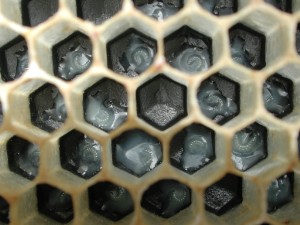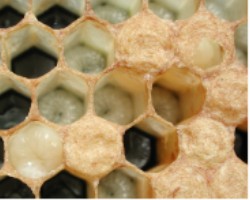Brood (honeybee)
|
|

Recently hatched honeybee larvae are feeding on royal jelly for three days. Only selected larvae for queens get royal jelly for longer.
The young of honeybees are collectively called brood. In Langstroth hives each frame which is mainly brood (usually with some pollen and nectar or honey in the upper corners) is called a brood frame. Hives that are rated for pollination purposes are generally evaluated in terms of the number of frames of brood.
In modern hives the nursery area is in the brood chamber, which is generally the bottom box. Some beekeepers ensure that the queen will not go into the upper boxes (called supers or honey supers) by placing a screen called a queen excluder between the boxes. The screen has precisely measured openings through which a worker bee can pass, but not a queen. Some beekeepers do not use excluders, but try to keep the queen within the intended brood area by keeping a honey barrier, of capped honey above the brood, which the queen is reluctant to cross. In wild honeybee hives the bees tend to put the brood at bottom center, and honey to the sides and above the brood, so beekeepers are trying to follow the natural tendency of the bees.
In the spring, just before bees would naturally split by swarming, beekeepers often remove frames of brood, with adhering bees, to make up new starter hives, called "nucs" or nucleus colonies. In areas where the climate is mild, one frame may be sufficient to start a new colony, with an added queen. But usually two to three frames are used, together with a frame that is predominantly honey. This insures that there will be enough adult bees to protect the brood from death by chilling overnight (aptly called "chilled brood"), and sufficient feed if there are a few rainy days when bees cannot gather nectar.
Bee brood frames are composed of eggs, larvae and pupae. In each cell of honeycomb, the queen lays an egg, glueing it to the bottom of the cell. As it hatches, worker bees add royal jelly, a secretion from glands on the heads of young bees. For three days the young larvae are fed royal jelly, then they are fed nectar or diluted honey and pollen. A few female larvae may be selected to become queens, and these are flooded with royal jelly for six days. This speeds up development, but also makes a larger adult, as she will have fully developed ovaries, ie. she will be sexually mature.

Older larvae in open cells. On the lower left is one about to pupate. On the upper right is one partly capped.
Young larvae eat their way through the royal jelly in a circular pattern (see photo above) until they become crowded (see photo at right), then they stretch out lengthwise in the cell. Soon they begin to spin a cocoon, and their older sisters cap the cell as they go into the pupa stage. These collectively are called "capped brood."
| Type | Egg | Larva | Cell capped | Pupa | Developmental Period | Start of Fertility |
|---|---|---|---|---|---|---|
| Queen | 3 days | 5 1/2 days | 7 1/2 days | 8 days | 16 days | approx. 23 days |
| Worker | 3 days | 6 days | 9 days | 12 days | 21 days | N/A |
| Drone | 3 days | 6 1/2 days | 10 days | 14 1/2 days | 24 days | approx. 38 days |
